Ireland is home to many iconic historical artifacts and objects, from the Book of Kells to the Tara Brooch. Many of these items are beautifully designed but shrouded in mystery. Others have a long and rich story behind them. There are few better examples of such an artifact than St. Patrick’s Bell and Shrine. Said to belong to St. Patrick himself, the bell and shrine have an unusually well-documented and fascinating history that stretches back some 1,400 years.
How Patrick became a Saint
The bell belonged to St. Patrick , the patron saint of Ireland. Despite his close links to the Emerald Isle, St. Patrick was actually born in Roman Britain around 385 AD. Little is known about Patrick’s early life, but we know he was the son of a deacon and the grandson of a priest. As a teenager, Patrick was captured and enslaved by Irish pirates for six years. During this time, he worked as a shepherd. He eventually escaped and returned home, where he spent a few years studying to become a priest.
After a few years had passed, Patrick had a vision telling him to return to Ireland. Patrick returned to Ireland and began preaching to the then- pagan people of Ireland , converting them to Christianity. Patrick would spend the rest of his life spreading the word of God and helping set up churches and parishes in Ireland. It was this work that led him to become the patron saint of Ireland . He received huge honors after his death, including having churches and cathedrals dedicated to him. He was also given a tomb when he died.
Around sixty years after his death, another missionary by the name of Colum Cille visited Patrick’s tomb and removed three relics from it. The first of these was a goblet, which was sent to County Down; the second was the “Angels Gospel”, which he kept for himself. The last relic was a small iron bell which he sent to Armagh, an important ecclesiastic site at the time and a place where Patrick had spent a lot of time.
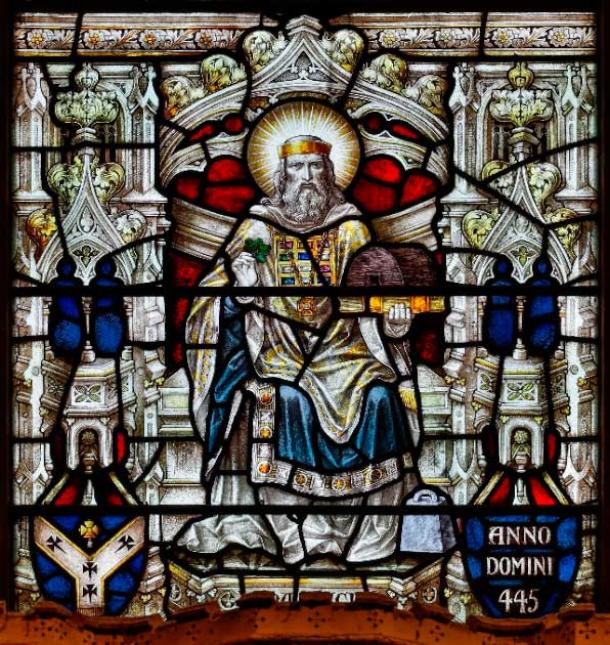
Stained glass depicting Saint Patrick and a reference to the year 445, when St. Patrick supposedly built the first church at Armagh. Located at St. Patrick’s Cathedral of the Church of Ireland, Armagh, County Armagh, Northern Ireland (Andreas F. Borchert, CC BY-SA 3.0 DE )
The History of St. Patrick’s Bell
According to legend, when St. Patrick set up a new Christian parish or community in Ireland, he would choose one of his disciples to lead it after he left. Before his departure, he would present his chosen disciple with a bell to call the locals to prayer. Apparently, in the province of Connaught alone he had presented over fifty bells, and he had three blacksmiths following him wherever he went, who were employed full-time to make the bells. St. Patrick’s bell was just like these bells.
When Colum Cille had the bell sent to Armagh, it was left in the hands of the Mulholland family. It remained in their possession and was largely forgotten about until the 18th century, when the last surviving member of their family, Henry Mulholland, transferred its ownership to Adam McClean, one of his school students. Mulholland told McClean before he died that there was an oak box buried in his backyard, and he was bequeathing it to him. In the box, McClean found St. Patrick’s bell and an ancient Irish Bible of equally significant value.
The bell and shrine remained in the possession of McClean until his death, before his family sold it to a professor at Trinity College Dublin. Then, the Royal Irish Academy became aware of the items and their importance and purchased them for £625, a hefty sum at the time.
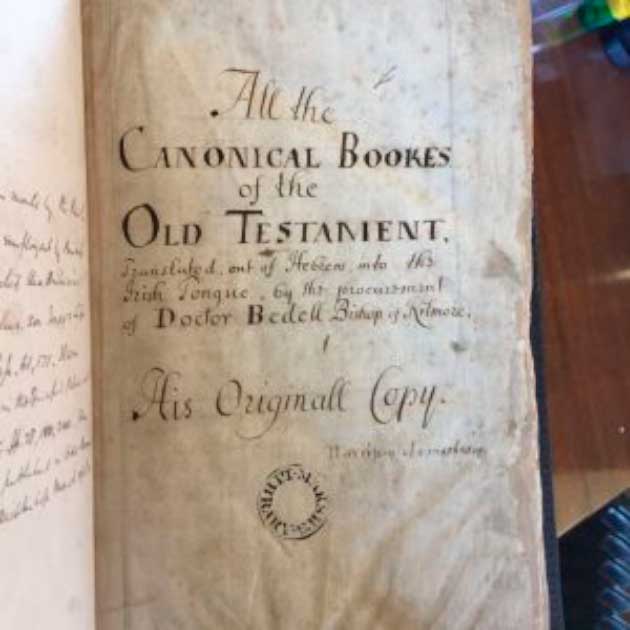
St. Patrick’s Bell and Shrine were recovered in the 18th century, along with the 17th century Bedell Bible, thought to be the first translation of the Old Testament into Irish (Marsh’s Library / CC BY NC ND 3.0 )
The Design of the Shrine
While the bell is, of course, of immense importance, it is the shrine it sits in that is the real eye-catcher. The bell has a rather humble design. It is made of two sheets of iron that have been riveted together. A bronze coating was added sometime after the bell was sent to Armagh by Colum Cille. The shrine, on the other hand, is intricate in its detail. The shrine was crafted at a later date than the bell. An inscription on its surface indicates it was made around 1100 AD. An inscription along the edge of the backplate also gives details on who made it (Cuduilig O Inmainen and his sons), and who commissioned it. The shrine was commissioned by the High King of Ireland Domhnall Ua Lochlainn. The keeper of the bell, Cathalan Ua Maelchallain (the Irish version of Mulholland) is also inscribed here.
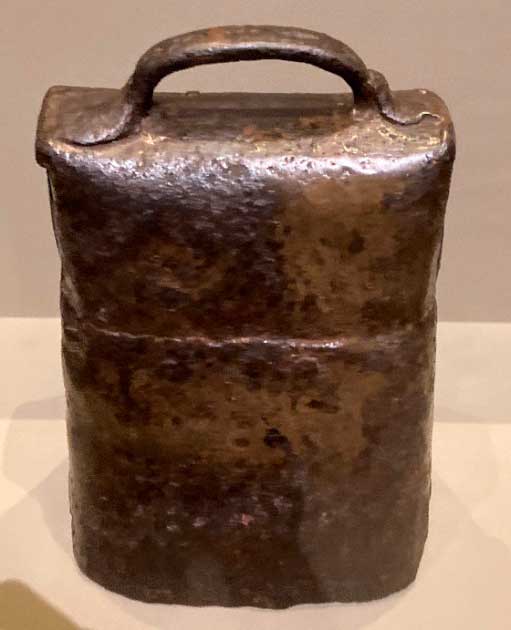
The humble St. Patrick’s Bell was fashioned in the 7th century, one of many commissioned as he established churches across Ireland (Ceoil / CC BY SA 4.0 )
The shrine is trapezoidal in shape with a curved crest at the top. There are two small handles on either side of the shrine to pick it up or handle it. The front panel is covered in a silver gilt frame that once held thirty panels of gold filigree arranged in the shape of a ringed cross. It also features numerous Celtic knot patterns. The sides of the shrine are adorned with openwork panels depicting elongated beasts intertwined with a pattern of snakes, possibly a reference to the legend of St. Patrick banishing the snakes from Ireland.
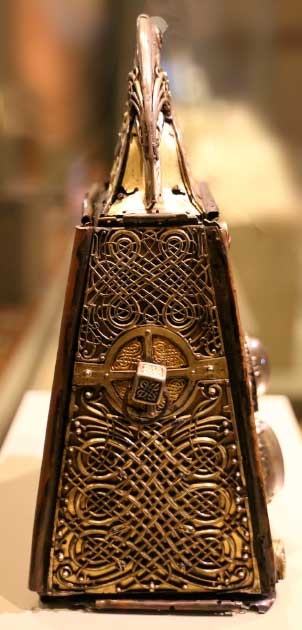
Detail of the sides of St. Patrick’s bell shrine (Sailko / CC BY 3.0 )
The back of the shrine, meanwhile, is much plainer in style. It is decorated with an openwork silver plate featuring a pattern of interlocking crosses. Finally, the top of the shrine is perhaps the most intricately decorated part. It features two birds made of iron, as well as several more panels of filigree and a beautiful, symmetrically-patterned design in what is a distinctly Viking-influenced Celtic pattern , known as Urnes style. Today, St. Patrick’s bell and shrine sit in the National Museum of Ireland.
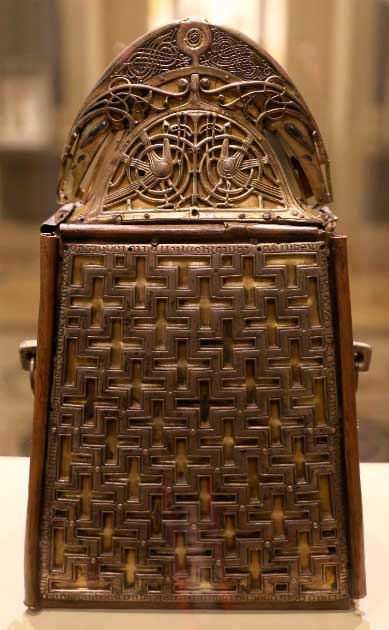
The back panel of St. Patrick’s bell shrine with interlocking crosses (Sailko / CC BY SA 3.0 )
Top image: St. Patrick’s Bell (left) is a simple design. The shrine (right) later designed to cover it is quite intricate. Source: National Museum of Ireland / CC BY SA 2.0
By Mark Brophy
Related posts:
Views: 0
 RSS Feed
RSS Feed

















 December 12th, 2022
December 12th, 2022  Awake Goy
Awake Goy  Posted in
Posted in  Tags:
Tags: 
















